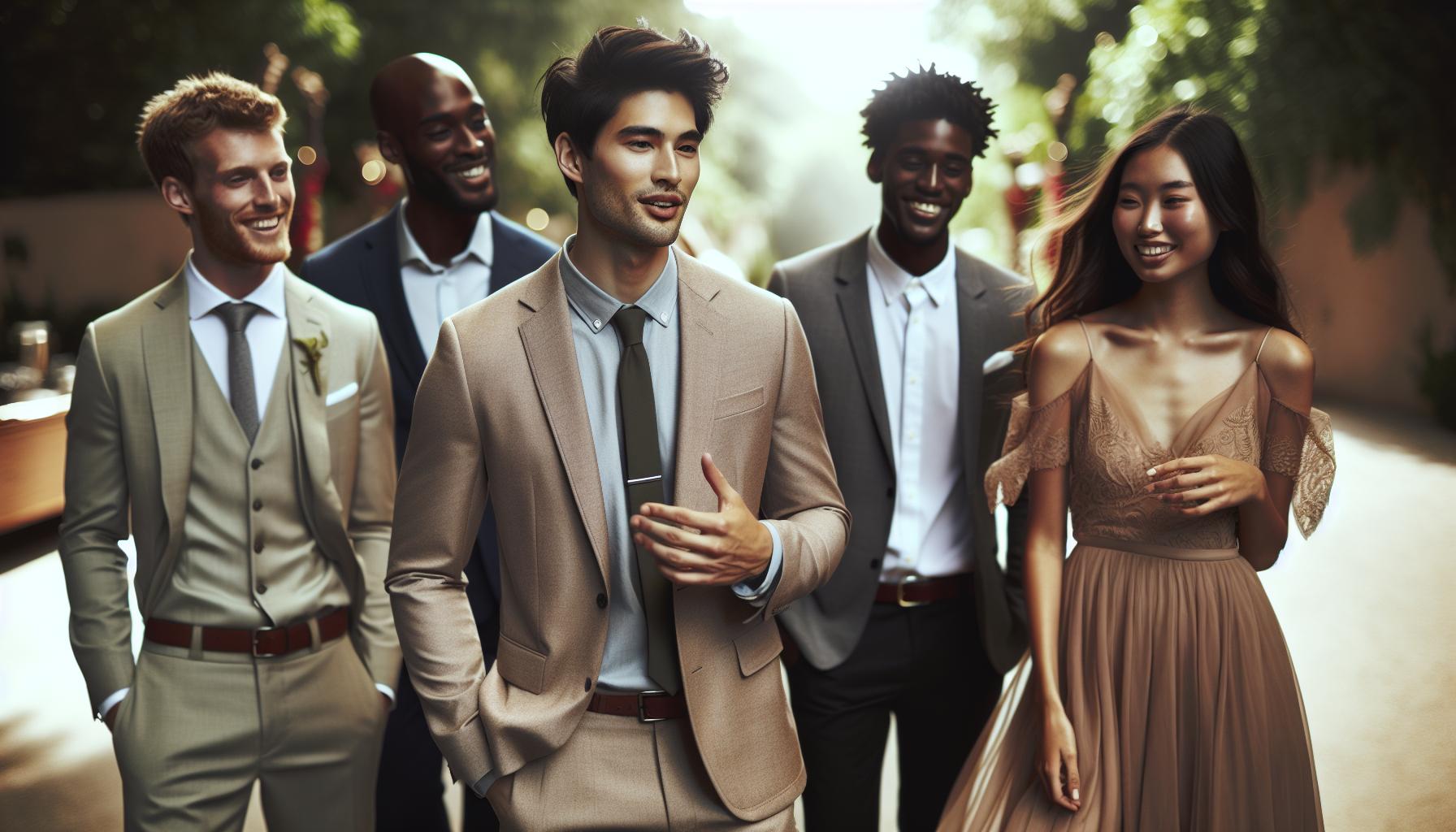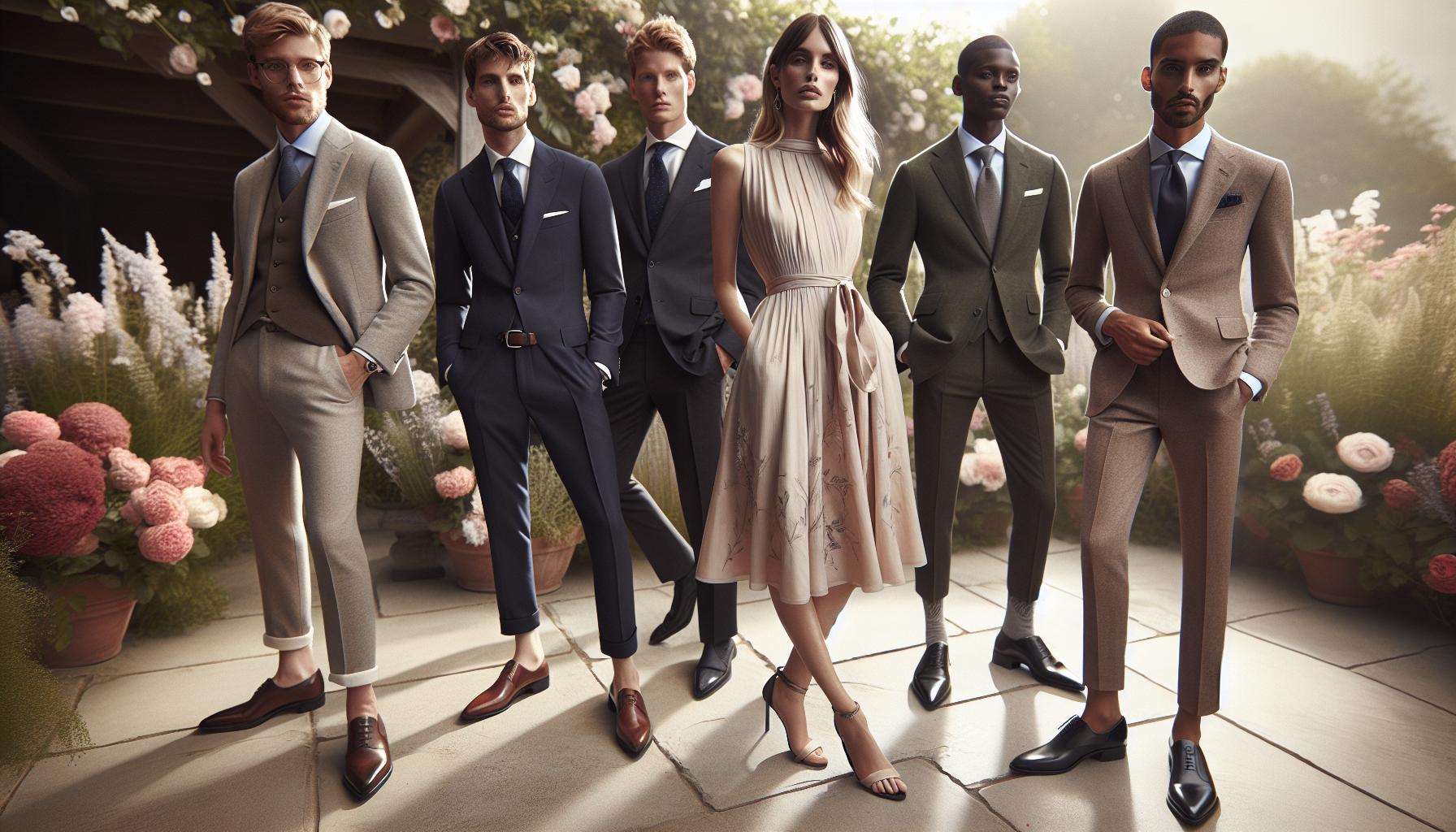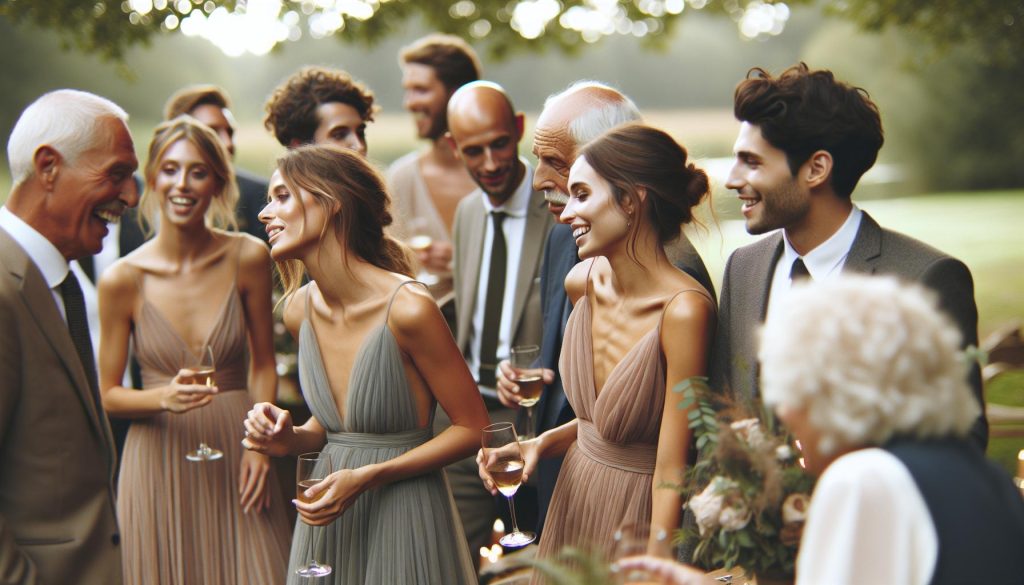Navigating wedding dress codes can often feel like solving a delightful puzzle-especially when it comes to the term “semi-formal.” This style balances elegance and comfort, making it vital for guests to understand its nuances to dress appropriately. For many, semi-formal evokes a sense of sophistication without the constraints of full formal attire, and mastering it ensures you feel confident and stylish on the big day. Whether you’re a guest trying to interpret the invite or part of the wedding party selecting your outfit, understanding the ins and outs of this attire can enhance your experience. Join us as we explore the rules of semi-formal dress codes for weddings, ensuring you’re perfectly attired for celebration and joy.
Understanding Semi-Formal Attire for Weddings

Understanding the nuances of semi-formal attire for weddings can be incredibly exciting yet occasionally overwhelming, especially when you’re navigating the delicate balance between elegance and comfort. Semi-formal is often defined as a sophisticated style that still embraces a relaxed vibe, making it ideal for modern weddings where couples wish to blend tradition with personal flair. The beauty of semi-formal attire lies in its flexibility-it allows guests to opt for outfits that reflect their personality while still adhering to the wedding’s overall tone.
When considering what constitutes semi-formal attire, think about fabrics, cuts, and colors that elevate your look without being overly extravagant. For men, this might mean a smart blazer paired with tailored trousers and a dress shirt, possibly complemented by a stylish tie or pocket square. Women can explore a variety of options, including cocktail dresses or elegant skirts with dressy tops-choosing materials like chiffon, silk, or velvet can add a touch of class. As you decide on your outfits, remember that the level of formality also hinges on the wedding’s theme, location, and time of day.
Moreover, the semi-formal dress code is not just about what to wear but also how to express one’s individuality within the stipulated guidelines. Consider accessorizing thoughtfully-neutral or metallic footwear and understated jewelry can enhance the overall look without overwhelming it. Incorporating seasonal colors can bring vibrancy to your ensemble, allowing you to stand out while still feeling part of the celebration. Ultimately, choosing semi-formal attire is about finding that sweet spot where you feel confident and ready to dance the night away, all while honoring the couple’s special day.
Key Components of Semi-Formal Dress Code

Understanding the finer details of attire is essential to truly embrace the festive spirit of a wedding. A semi-formal dress code strikes a delightful balance, allowing guests to feel polished yet relaxed. This attire level invites personal expression while ensuring that everyone looks stunning and appropriately dressed for the occasion. To help navigate this exciting territory, let’s explore the key components that define semi-formal attire for weddings.
To start, it’s crucial to know what constitutes appropriate fabrics and styles. Men typically opt for well-fitted suits in classic colors like navy, charcoal, or even lighter shades for daytime events. A dress shirt and a tie add a touch of sophistication, while loafers or oxfords complete the look. Women have a delightful range of options, from cocktail dresses and midi-length skirts to dressy jumpsuits. Fabrics such as lace, chiffon, or silk can enhance elegance, while colors and prints may vary based on the season-think pastels for spring or richer tones for fall weddings.
Accessorizing plays a pivotal role in elevating semi-formal attire. For men, subtle touches like a pocket square or a unique cufflink can make the outfit pop. Women are encouraged to choose statement jewelry or a stylish clutch, ensuring that their accessories complement rather than overshadow their outfit. It’s also wise to consider the wedding’s overall theme, as well as the venue, when selecting accessories that resonate with the occasion.
Lastly, understanding the different expressions of semi-formal attire is key. Venue plays a significant role; for a beach wedding, one might opt for lighter fabrics and more casual footwear, while a garden party might call for floral prints and elegant sandals. Ensuring that your attire respects the couple’s vision while embracing your individuality will create a harmonious celebration atmosphere, allowing everyone to revel in the joy of love and commitment.
When guests embrace these elements of semi-formal attire, they contribute not just style but a sense of unity and respect for the special day-a perfect blend of personal flair and collective celebration.
What to Look for in Semi-Formal Attire
Choosing the right attire for a wedding that calls for a semi-formal dress code can be both exciting and daunting. It offers a unique blend of sophistication and comfort, allowing you to express your personal style while adhering to the anticipated standards of the occasion. To navigate this style spectrum effectively, consider several key elements that will ensure you look and feel your best on this special day.
When selecting semi-formal attire, prioritize well-fitted clothing that flatters your figure. For men, this often means opting for a tailored suit in classic shades-think navy, gray, or charcoal-paired with a crisp dress shirt. Adding a tie or a pocket square can elevate the look, lending an air of refinement. Women, on the other hand, have a versatile array of options, from chic cocktail dresses to elegant midi-length skirts. Fabrics are crucial; lightweight materials like chiffon or silk not only enhance comfort but also deliver a graceful drape suitable for dancing the night away.
Accessories serve as the perfect finishing touch to your semi-formal ensemble. For men, consider tying the outfit together with polished dress shoes and understated jewelry, such as cufflinks or a sleek watch. Women can opt for statement pieces-perhaps a bold necklace or eye-catching earrings-that compliment, rather than overpower, their outfits. A well-chosen handbag or clutch can also add a stylish touch while providing practicality for essentials.
As you prepare your attire, keep the venue and season in mind. For outdoor or beach weddings, lighter fabrics and colors may be more appropriate, while an indoor evening celebration might call for deeper hues and richer textiles. Seasonal considerations also play a pivotal role; pastels often shine in spring, while autumn weddings often embrace jewel tones. Ultimately, aligning your attire with the overall wedding theme and respecting the couple’s vision will ensure a seamless, joyous celebration where guests feel as splendid as the day itself.
Semi-Formal Dress Code for Guests: Dos and Don’ts
Understanding the nuances of semi-formal attire can transform the wedding experience for both guests and hosts, allowing everyone to celebrate in style while feeling comfortable. Adhering to the semi-formal dress code ensures you honor the couple’s wishes while showcasing your personal flair. Here are essential dos and don’ts to guide you seamlessly through choosing the perfect outfit.
Dos
- Do RSVP Promptly: Your response helps in planning, and it often comes with specific dress code information.
- Do Consider the Venue: Match your outfit to the wedding’s location. Outdoor weddings may call for lighter materials, while elegant indoor settings might embrace bolder choices.
- Do Accessorize Wisely: Elevate your look without overshadowing it. Thoughtfully chosen accessories can enhance your outfit without becoming a focal point.
- Do Pay Attention to Color Palettes: While vibrant hues can be suitable, always consider the couple’s chosen colors and theme. Soft pastels for spring and rich jewel tones for fall can set the perfect tone.
Don’ts
- Don’t Overdress or Underdress: Striking the right balance is crucial. A floor-length gown may be too formal, while jeans and a t-shirt can lean too casual.
- Don’t Ignore the Weather: Comfort is key. Ensure your attire is suitable for the season to enjoy the day fully-sweating in heavy fabrics or shivering in light ones can detract from the joy of the celebration.
- Don’t Wear White (or Ivory): Traditionally, these colors are reserved for the bride, and wearing them can be seen as upstaging or disrespecting her special day.
- Don’t Be Distracting: Choose outfits that are sophisticated but not showy. Overly glamorous pieces or flashy accessories may redirect attention away from the couple.
Embracing the semi-formal dress code for weddings allows you to present a polished appearance while enjoying the celebration. By following these straightforward dos and don’ts, you’ll help create a beautiful atmosphere that honors the couple and enhances the overall experience for everyone involved. Remember, weddings are about love and joy, and your choice of attire is a way to contribute to the occasion’s magic.
Semi-Formal Dress Styles for Bride and Groom
When it comes to the semi-formal dress code for the bride and groom, striking the right balance between elegance and comfort is essential. This attire should reflect not only the couple’s personal style but also the wedding’s overall ambiance. A semi-formal setting allows for a range of fashionable options that are both chic and understated, providing an excellent opportunity for couples to showcase their individuality while staying within the guidelines of the occasion.
For the bride, a semi-formal wedding dress can take many forms. Opting for a knee-length or tea-length gown can beautifully combine tradition with modern flair. Fabrics like chiffon, lace, or silk can create a sophisticated look while remaining comfortable enough for dancing later in the evening. A-line silhouettes or structured fit-and-flare designs can be flattering on various body types, allowing the bride to feel confident and radiant. Embellishments such as delicate embroidery or tasteful beadwork can elevate the style without overwhelming the overall aesthetic.
The groom’s attire is equally important in this setting. A well-tailored suit in a classic shade like navy, charcoal, or a lighter hue for summer weddings can effortlessly align with the semi-formal theme. Pairing this with a crisp dress shirt and a tie or bowtie enriches the look, setting a polished tone that complements the bride’s outfit. For a more relaxed vibe, a nice blazer with dress trousers can provide the right mix of sophistication and comfort, especially in outdoor or destination weddings.
Accessorizing the Look
Accessorizing should enhance the couple’s style without drawing too much focus. Brides can consider dainty jewelry, a tasteful clutch, and comfortable yet stylish shoes to ensure they can move gracefully throughout the day. Grooms may choose understated cufflinks, a stylish watch, or a pocket square that coordinates with the wedding colors to add that polished touch. By thoughtfully selecting their outfits and accessories, couples can ensure they not only look stunning but also feel great, ready to enjoy every precious moment of their special day.
Accessorizing for a Semi-Formal Wedding
The right accessories can elevate your semi-formal wedding attire, adding personal flair while remaining in line with the overall aesthetic of the event. For the bride, incorporating elements that reflect her unique style enhances her look without overshadowing the elegance of the dress. Jewelry plays a crucial role; delicate pieces like a pendant necklace or a pair of stud earrings can add just the right amount of sparkle. Brides may also opt for a statement piece-a vintage brooch or a floral hair accessory-that complements the color scheme of their wedding. Comfortable yet chic footwear, such as elegant mid-heeled sandals or flats, is ideal for long hours of celebration while maintaining grace.
For the groom, accessories serve to tie the ensemble together and can reflect personal taste or the wedding’s theme. A well-chosen tie or bowtie can act as a focal point, particularly if it features colors that harmonize with the bridal bouquet or overall decor. A pocket square, pocket watch, or stylish cufflinks can add elegance and flair to a classic suit. Opting for a patterned tie in muted tones can introduce visual interest without overwhelming the overall look.
Consider Seasonal Themes and Color Palettes
It’s also important to consider the season and color palette established for the wedding when selecting accessories. For summer weddings, lighter fabrics and bright colors can invoke a fresh and lively atmosphere. Think about natural elements, such as floral crowns for the bride or floral ties for the groom, that echo the beauty of the season. In contrast, winter weddings may inspire the use of richer hues and more textured fabrics like velvet or cashmere, with accessories that include cozy scarves or elegant gloves.
By thoughtfully pairing clothing with the right accessories, couples can enhance their semi-formal wedding attire, ensuring they feel confident, comfortable, and completely in tune with their celebration. Ultimately, the goal is to create a harmonious look that reflects both their individual styles and the joyous occasion of their union.
Color Palettes and Seasonal Considerations
Choosing the right color palette and considering seasonal themes are pivotal aspects of planning semi-formal wedding attire, as they contribute to the overall aesthetic and mood of the event. The colors you select will not only reflect the couple’s personality but also set the tone for the guests’ outfits and the decor. For instance, soft pastels like blush, mint, or lavender are perfect for spring weddings, evoking a sense of renewal and freshness, while bold jewel tones such as emerald, sapphire, or ruby can lend a touch of elegance and richness during the fall and winter months.
Seasonal Color Inspirations
Understanding seasonal influences can guide choices in attire and accessories:
- Spring: Favor light, airy fabrics and colors reminiscent of blooming flowers, like pale pinks, soft yellows, and greens. Accessories can include floral accents or delicate jewelry to embody the season’s spirit.
- Summer: Bright, vibrant colors such as coral, turquoise, and sunny yellows resonate well. Lightweight fabrics like cotton or linen help combat the heat, while playful designs celebrate the joyful atmosphere.
- Autumn: Embrace rich, earthy tones like burnt orange, deep burgundy, and mustard yellow. Texture becomes significant; consider materials like tweed and silk to add warmth to the attire.
- Winter: Opt for darker shades like navy, forest green, or even classic black, complemented by metallics or jewel tones for a sophisticated flair. Fabrics like velvet or satin enhance the luxurious feel of winter weddings.
Incorporating these seasonal color palettes not only helps in creating a cohesive look throughout the wedding but also allows for creative expression. Consider how floral arrangements can coordinate with the attire, enhancing the visual unity of the celebration.
Accessorizing with Purpose
The choice of accessories should also harmonize with both the color palette and the season. For summer, think lightweight embellishments like airy shawls or bright statement earrings. In winter, heavier accessories might include elegant scarves or gloves that add both style and comfort. Couples should feel encouraged to personalize their looks, whether through unique patterns or pops of color that stand out against the overall theme.
As guests select their attire, being mindful of the established color palette will not only keep the event visually pleasing but also ensure that everyone feels connected to the communal celebration. By thoughtfully considering both color and season, each couple can curate a stunning ensemble reflective of their style while embracing the joyous atmosphere of their wedding day.
Semi-Formal Attire for Different Wedding Venues
Choosing the right attire for a semi-formal wedding varies significantly depending on the venue, as each setting carries its own unique ambiance and expectations. Understanding these nuances ensures that you not only look stylish but also feel comfortable and appropriate for the occasion. A semi-formal dress code strikes a balance between casual and formal attire, allowing you to showcase your personality while respecting the event’s overall aesthetic.
When attending a beach wedding, opt for lightweight fabrics and breathable materials. Women might consider flowy maxi dresses or sundresses paired with chic sandals, while men can go for linen trousers with a crisp button-up shirt, potentially adding a blazer for a polished touch. It’s essential to steer clear of overly formal shoes, as comfort is key on sandy terrain.
In contrast, a garden wedding can offer a picturesque backdrop that invites slightly more elegance. Here, a floral midi dress or jumpsuit complemented by wedges or block heels works well for women. Men might choose dress pants and a tailored shirt, potentially adding a tie or bow tie. Embrace playful colors and patterns that enhance the natural vibe, while avoiding heavy fabrics that could clash with the blossoming surroundings.
For a vintage-inspired wedding held in a historic venue, think along the lines of sophistication with a hint of whimsy. Women might gravitate towards tea-length dresses featuring lace or intricate details, paired with vintage accessories. Men can opt for tailored suits in muted tones, perhaps with a waistcoat or suspenders for a classic touch. In these environments, focusing on textures and accessories can elevate the overall look, creating a cohesive vintage vibe.
Finally, when attending a city hall wedding or an indoor ceremony, style can embrace sleek and modern elements. A tailored jumpsuit or a chic sheath dress with minimalistic accessories can be a striking choice for women, while men may select sharp suits with contemporary cuts. Here, the emphasis can be on clean lines and sophisticated color palettes that resonate with the urban setting, allowing you to blend fashion-forward ideas with semi-formal standards.
In each case, the venue not only influences attire selections but also sets the tone for how guests can personally express themselves, allowing for individual flair while celebrating the beautiful union taking place. By considering the specific characteristics of the venue, you ensure that your outfit aligns perfectly with the event’s spirit and ambiance.
Cultural Variations on Semi-Formal Dress
When it comes to semi-formal attire for weddings, cultural variations play a significant role in dictating what guests should wear, blending traditional expectations with modern sensibilities. Understanding these cultural nuances not only enhances your own experience but also shows respect for the couple’s heritage and family traditions. For example, in many Western cultures, semi-formal attire might mean cocktail dresses for women and tailored suits for men. However, in Asian cultures, you might find that formal cheongsams or traditional outfits are celebrated as appropriate attire, even in a semi-formal setting.
In African cultures, vibrant colors and intricate patterns often characterize semi-formal weddings. Guests might be encouraged to wear traditional garments, such as kente cloth, which not only pays homage to heritage but also adds a festive flair to the occasion. Couples from multicultural backgrounds may blend these traditions, allowing guests the freedom to express their cultural identities through their fashion choices while adhering to the semi-formal dress code.
It’s also important to consider regional climate variations. In warmer climates, semi-formal wear may lean towards lighter fabrics, like linen or cotton, while cooler regions may allow heavier materials and layers. Additionally, many cultures incorporate specific color symbolism into their wedding attire. For instance, in Indian weddings, red is a popular choice because of its association with good fortune, whereas in some African cultures, certain colors may represent community ties or present status within the family.
To communicate these cultural expectations effectively to guests, couples can include attire guidelines in their invitations or wedding websites. By sharing a brief note on cultural attire preferences, you not only educate attendees but also enhance the celebratory atmosphere, allowing everyone to engage fully in the joyous occasion. Understanding and embracing these variations enriches the wedding experience, making it even more meaningful for the couple and their loved ones.
How to Communicate Semi-Formal Dress Code to Guests
In the joyful chaos of wedding planning, communication with guests is crucial, especially when it comes to the dress code. Ensuring that everyone understands the semi-formal attire expectation not only enhances the celebration but also helps guests feel confident and comfortable. When you effectively convey what ‘semi-formal’ entails, you set the tone for a stylish, polished event that honors the couple’s vision.
One of the easiest ways to communicate the semi-formal dress code is to include a detailed note in your wedding invitations. Use clear, inviting language, and consider adding a brief description or example of what this attire looks like. Phrases like, “We invite you to celebrate in semi-formal attire-think elegant cocktail dresses for women and tailored suits for men,” can guide your guests without making them feel restricted. Adding an inspiration board on your wedding website showing examples of appropriate outfits can also be immensely helpful, providing visual cues that clarify what you envision.
Utilizing social media and digital platforms can further enhance your communication efforts. If you have a wedding hashtag, share tips and ideas regarding the dress code leading up to the big day. Creating an FAQ section on your wedding website can address common questions about attire while reinforcing the semi-formal theme. This not only makes the information accessible but also encourages guests to engage with the wedding festivities online.
Lastly, consider enlisting the help of close friends or family members in the communication process. If your guest list includes attendees unfamiliar with semi-formal attire, having a go-to person who can answer questions or provide advice fosters an inclusive environment. By collaborating with your loved ones in sharing this information, you ensure that no one feels excluded or uncertain about how to dress for your celebration, making the entire event more enjoyable and cohesive.
Common Mistakes to Avoid with Semi-Formal Attire
Choosing the right outfit for a semi-formal wedding can be a delightful challenge, but a few common pitfalls can turn excitement into stress. One of the primary mistakes is misinterpreting the semi-formal dress code. Guests often err on one side or the other-either over-dressing in full formal attire, such as a floor-length gown or a tuxedo, or under-dressing in casual wear like jeans and a t-shirt. Understanding that semi-formal attire sits elegantly between these two extremes is vital. Women can opt for cocktail dresses or stylish skirts and blouses, while men may wear tailored suits without needing a tie to keep it less formal.
Another frequent mistake is neglecting the venue and season when selecting an outfit. A beach wedding, for example, might call for lighter fabrics and colors, while an evening event in a more traditional setting lends itself to darker, richer hues. Ignoring these elements can lead to discomfort or even embarrassment during the ceremony. Guests should consider the setting and time of year in their fabric choices and styles-light gauzy materials for summer and heavier fabrics for winter weddings.
Accessorizing is also an area where guests may stumble. Overdoing it with bold jewelry or oversized accessories can clash with the subtlety of semi-formal attire. Aim for a balanced look by choosing complementary accessories that enhance rather than overwhelm your outfit. Women might consider delicate jewelry that adds a touch of elegance, while men can complete their look with understated watches or cufflinks.
Lastly, a common yet easily avoidable mistake is not taking the time to groom oneself appropriately. Semi-formal attire is all about polished elegance, so personal grooming is key. Make sure footwear is clean and suitable for the venue, and remember that well-maintained hair and makeup can elevate an outfit tremendously. By being mindful of these details, guests set the stage for an enjoyable wedding experience, celebrating the couple in style while feeling confident in their appearance.
Real Wedding Examples of Semi-Formal Style
Weddings often serve as beautiful showcases of style and personal expression, and understanding semi-formal attire through real wedding examples can illuminate the essence of this dress code wonderfully. Imagine a spring wedding set in a charming garden, where the scent of blooming flowers fills the air. Guests are dressed in vibrant colors that reflect the season-ladies are adorned in knee-length floral dresses paired with elegant flats, while gentlemen opt for light-colored suits and crisp dress shirts. This setting exemplifies how guests skillfully balance sophistication with a friendly atmosphere, paying homage to the semi-formal guideline of looking polished yet approachable.
Another scenario might unfold at a vintage-inspired wedding held in a rustic barn. Here, both the bride and groom choose semi-formal aesthetics that resonate with the surroundings. The bride dons a lace tea-length dress with delicate sleeves, complemented by a simple floral crown. Her choice embodies timeless elegance without the extravagance of a ball gown. The groom pairs tailored trousers with a vest and bow tie, creating a look that echoes the charm of the venue. This example highlights the importance of considering the wedding’s theme and location while selecting attire.
When it comes to accessorizing, real wedding experiences showcase how understated pieces can elevate a semi-formal look. Guests frequently choose minimalistic jewelry-think delicate earrings or elegant wrist watches that offer a hint of sophistication without stealing the spotlight. A couple celebrating their love by the beach might have guests don airy garments adorned with shell-themed accessories, perfectly blending casual elegance with the semi-formal aesthetic. This thoughtful coordination not only enhances their attire but also creates a cohesive visual storytelling experience throughout the celebration.
Lastly, reflecting on a chic city wedding at a sleek rooftop venue, we see how guests adapt to a modern semi-formal vibe. Here, the femininity of a structured midi dress is beautifully juxtaposed with the sharpness of tailored suits on the men. The ambiance is enriched by the backdrop of a sunset-drenched skyline, illustrating how semi-formal attire can be both contemporary and timeless. Cohesion in color schemes-such as deep blues paired with elegant gold accents-exemplifies an understanding of the dress code that perfectly marries style with the couple’s vision for their special day.
These spirited examples illustrate the versatility and creativity surrounding semi-formal attire for weddings, making each celebration uniquely tailored to the couple and the occasion, while guiding guests in making stunning fashion choices that resonate with the joyful atmosphere of the day.
Frequently Asked Questions
Q: What is considered semi-formal attire for a wedding?
A: Semi-formal attire for a wedding typically includes cocktail dresses for women and dress slacks with a blazer for men. Dresses should be elegant but not overly formal, while men can opt for dress shoes. Check out our section on Key Components of Semi-Formal Dress Code for more details.
Q: Can I wear a long dress to a semi-formal wedding?
A: Yes, you can wear a long dress to a semi-formal wedding, but it should be less formal than a full evening gown. Opt for a dress that is elegant yet understated, perhaps with lighter fabrics or simpler designs. For styling tips, see our section on Semi-Formal Dress Styles for Bride and Groom.
Q: Are khakis acceptable for semi-formal weddings?
A: Khakis may be considered acceptable for semi-formal weddings, particularly in less formal settings or outdoor venues. However, pairing them with a blazer and nice shoes is crucial to maintain a polished appearance. Refer to our guide on Semi-Formal Attire for Different Wedding Venues for more insights.
Q: What colors are appropriate for semi-formal wedding attire?
A: Appropriate colors for semi-formal wedding attire include jewel tones, soft pastels, and classic neutrals. Consider matching your outfit to the season or wedding theme. For a deeper dive, check out our section on Color Palettes and Seasonal Considerations.
Q: How do I communicate a semi-formal dress code to guests?
A: Communicating a semi-formal dress code can be done through invitations by specifying “semi-formal attire requested.” Additionally, including examples of appropriate outfits can help clarify expectations. Explore our tips in How to Communicate Semi-Formal Dress Code to Guests for more ideas.
Q: Can I wear sandals to a semi-formal wedding?
A: While it’s best to opt for dress shoes, stylish sandals can be acceptable in warmer weather, especially if they are elegant. Avoid casual flip-flops or overly casual designs. For accessorizing tips, see our section on Accessorizing for a Semi-Formal Wedding.
Q: What should I avoid wearing to a semi-formal wedding?
A: Avoid overly casual clothing like jeans, T-shirts, or sneakers, as well as clothing that is too formal, such as ball gowns and tuxedos. Keep the look polished and respectful. Learn more in our section on Common Mistakes to Avoid with Semi-Formal Attire.
Q: Are there cultural variations for semi-formal dress codes at weddings?
A: Yes, cultural variations exist, and semi-formal may differ based on cultural traditions. It’s important to consider cultural norms and expectations when selecting attire. Refer to our discussion on Cultural Variations on Semi-Formal Dress for more.
To Conclude
Understanding the nuances of a semi-formal wedding dress code is essential for guests wanting to strike the perfect balance between elegance and comfort. Remember, your outfit helps set the tone for the celebration, so choose wisely to make a lasting impression! If you’ve found this guide helpful, consider exploring our resources on attire selection and wedding etiquette to deepen your knowledge. Don’t forget to check out how to master invitation wording for every occasion.
To stay updated on all things wedding-related, subscribe to our newsletter or join our community for insights and tips to make your special day perfect. Your journey to wedding bliss continues here-let’s make every detail count! Feel free to share your thoughts or ask questions in the comments, as we’re excited to be part of your celebration!











